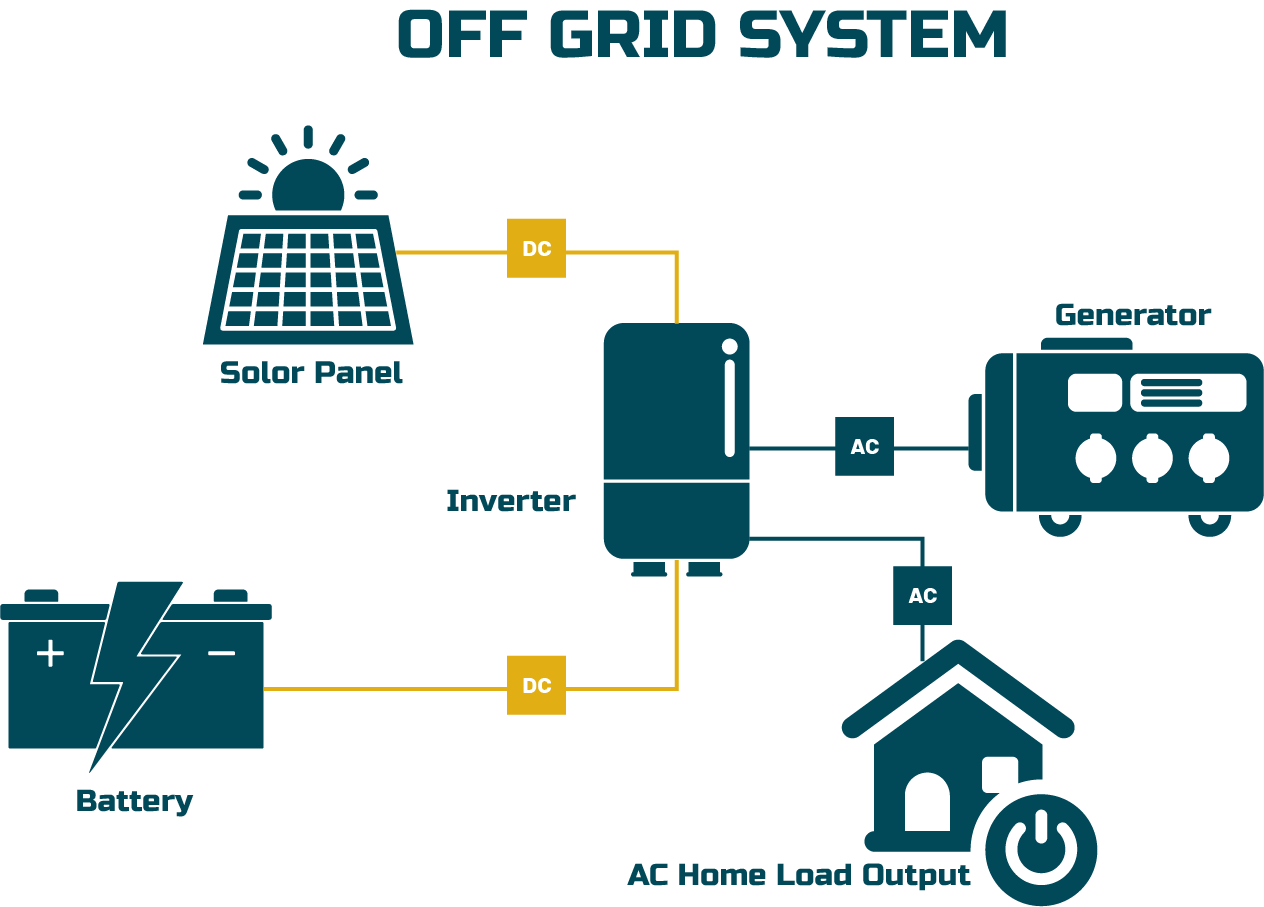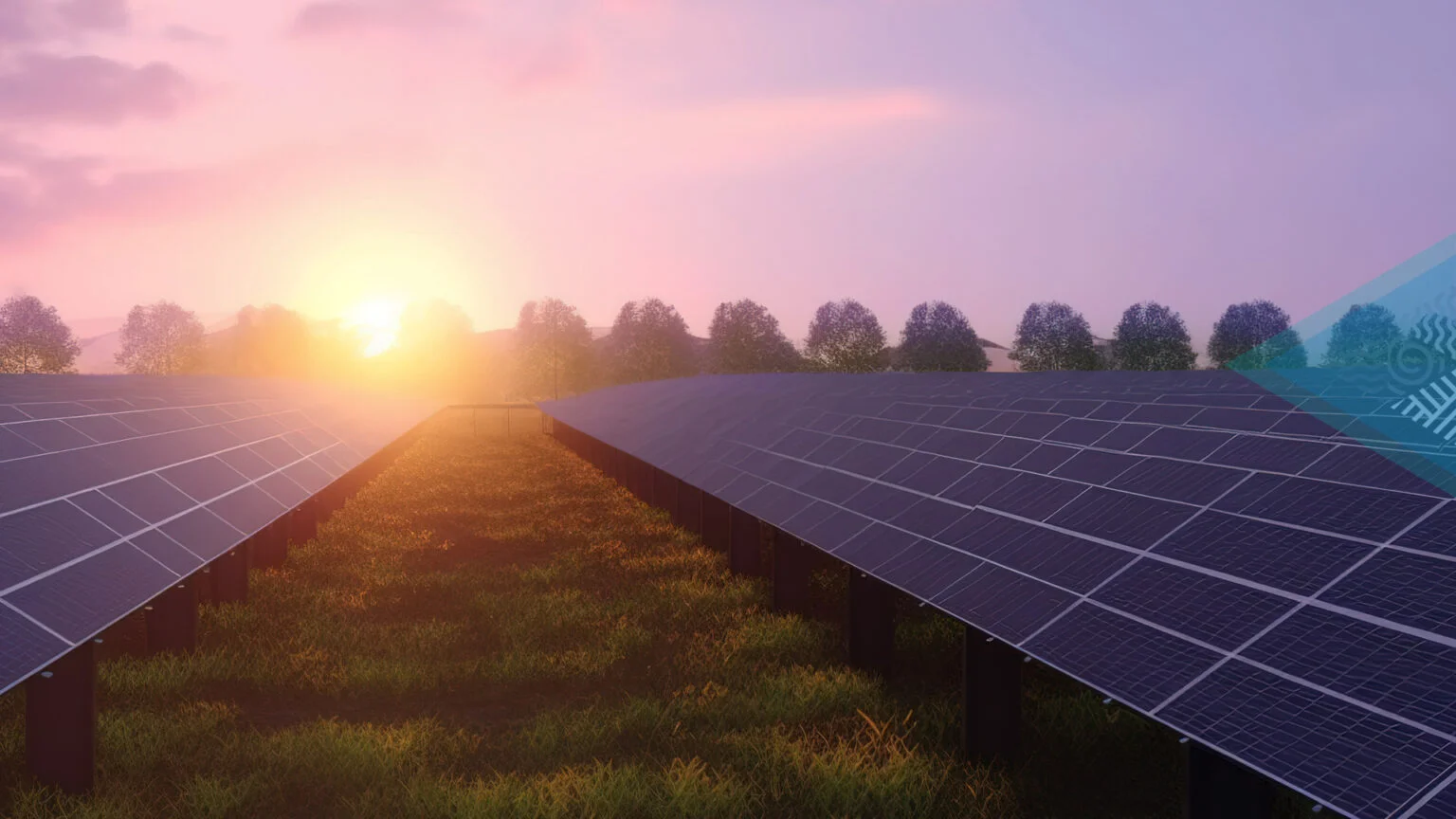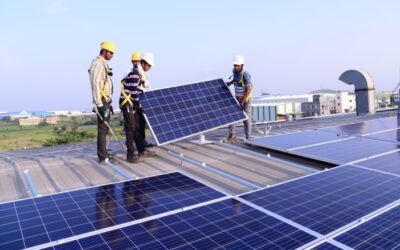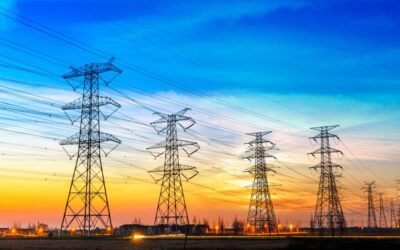Overview of Off -Grid
Solar Systems
An off-grid solar system, also known as a standalone solar system, operates independently from the main power grid. It functions as a self-sufficient energy island, composed of the following components:

Working of an Off-Grid
Solar System for Homes
The operation of an off-grid solar system is straightforward:
1. Solar Panels
Absorb sunlight and convert it into DC electricity.
2. Combiner Box
Collects DC current from the panels.
3. Charge Controller
Manages the flow of DC electricity, charging the batteries and supplying power to the inverter.
4. Batteries
Store excess electricity for use during non-sunlight hours.
5. Inverter
Converts DC power to AC power for household appliances.
6. Battery Management
Modern inverters include built-in battery management systems to ensure efficient energy use.
Off Grid Solar Components and Their Functions
1. Solar Panels
Solar panels are composed of solar cells, which can be either monocrystalline (single silicon crystal) or polycrystalline (multiple silicon crystals). Both types capture sunlight and convert it into direct current (DC) electricity. For optimal performance, ensure the panels are installed without any shadow interference.
2. Solar Inverter
Since household appliances require alternating current (AC) power, the solar inverter plays a crucial role by converting the DC power generated by the solar panels into AC power. The inverter is the heart of the off-grid solar system.
3. Batteries
Batteries store the excess electricity produced during the day for use at night. During sunlight hours, the electricity generated by the panels powers the home, and any surplus is stored in the batteries.
4. Charge Controller
The charge controller manages the flow of electricity from the solar panels to the batteries and the inverter. It ensures the batteries are charged properly and prevents overcharging.
5. Mounting Structures
Mounting structures are essential for positioning the solar panels at the correct tilt angle to maximize sunlight exposure. High-quality, hot-dipped zinc galvanized structures provide durability and rust resistance.
6. Solar Accessories
Various accessories are necessary for a safe and efficient off-grid solar system, including:
- DC cables and combiner box
- AC cables and combiner box
- MC4 connectors
- Earthing strips and conduit trays
- Lightning arrester

Off-Grid Solar Systems with Different Capacities
Off-grid solar systems come in various capacities, generating different amounts of electricity:
| Capacity | Units Generated / Day | Units Generated / Year |
|---|---|---|
| 1 kW | 4 units | 1440 units |
| 2 kW | 8 units | 2880 units |
| 3 kW | 12 units | 4320 units |
| 4 kW | 16 units | 5760 units |
| 5 kW | 20 units | 7200 units |
| 10 kW | 40 units | 14400 units |
The higher the capacity of the system, the more electricity it generates. Choose a system that meets your power requirements.
Cost of an Off-Grid
Sola Power System
The cost of an off-grid solar system, including procurement, installation, and post-installation services, ranges between ₹85-100 per watt peak. The final cost depends on the battery backup required. Larger batteries for longer backups increase the overall cost.
Return on Investment (ROI)
of an Off-Grid System
Off-grid solar systems typically break even in about 6-7 years due to the high cost of batteries. Despite the longer ROI period, the system provides clean, green energy and is more economical than grid electricity from fossil fuels.
Benefits of Using an Off-Grid Solar System
- Ideal for Remote Areas: The only option where grid access is unavailable, such as rural areas.
- Environmentally Friendly: Generates clean energy without causing pollution.
- Cost-Effective: Despite a longer ROI period, it is more economical than expensive fossil-fuel-based grid electricity.
Conclusion
An off-grid solar system is an excellent solution for areas without grid access. While the initial investment may take 6-7 years to break even, it ultimately provides significant long-term savings and environmental benefits.
What is an off-grid solar system?
An off-grid solar system operates independently from the main power grid, using solar panels to generate electricity and batteries to store excess power for use during non-sunlight hours.
What is the drawback of an off-grid solar system?
The primary drawback is the cost, particularly of the batteries, which makes the system more expensive and results in a longer ROI period of about 6-7 years.
How does an off-grid solar system work?
Solar panels generate DC power, which is managed by a charge controller and stored in batteries. The inverter converts the DC power to AC power for household use. Excess power is stored in the batteries for use during non-sunlight hours.
Recent Projects




Submit a
Solar Project Enquiry
Our solar experts will guide you in your solar journey
Request A Quote
Recent Blogs
Rooftop Solar Installation in Coimbatore: Powering Homes & Businesses the Smart Way
Coimbatore is one of Tamil Nadu’s fastest-growing cities — with thriving industries, educational institutions, and residential zones. Rising electricity costs, frequent power...
Why Accurate Energy Forecasting Matters for Every Industry in Coimbatore
In today’s fast-paced world, energy is more than just a utility—it’s a strategic business resource. Whether it’s a manufacturing plant, hospital, IT company, or retail chain in...
Solar Manufacturing: Powering the Future of Clean Energy with Klymate
The global shift toward renewable energy has placed solar manufacturing at the heart of the clean energy revolution. From creating high-efficiency solar cells to producing...



